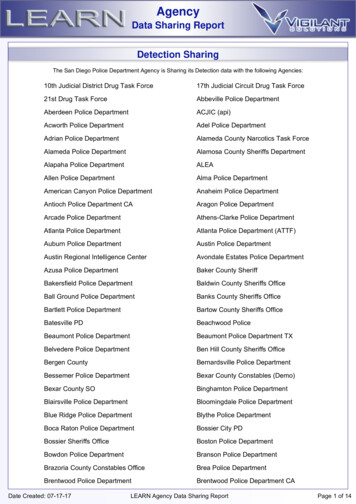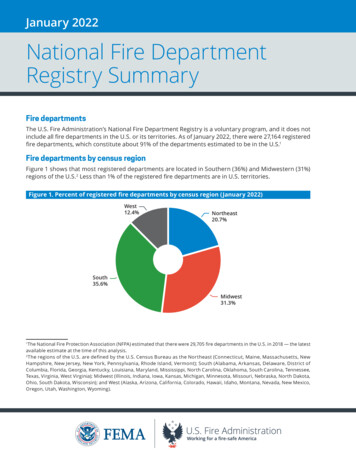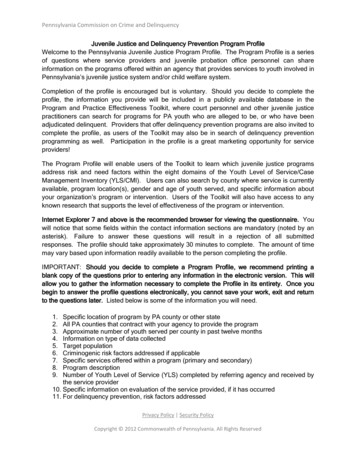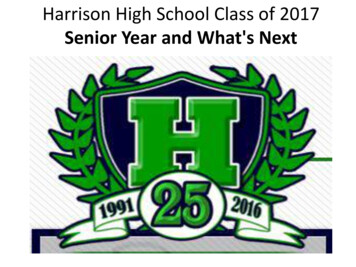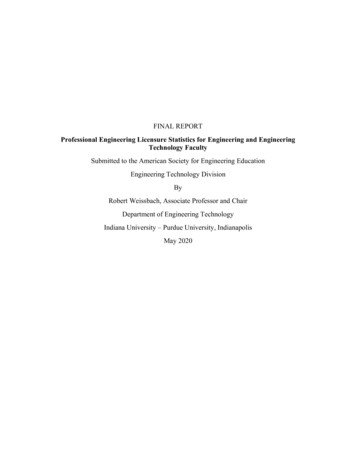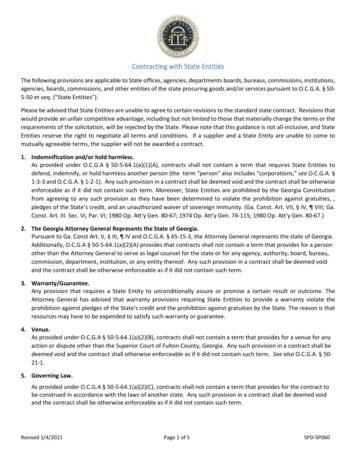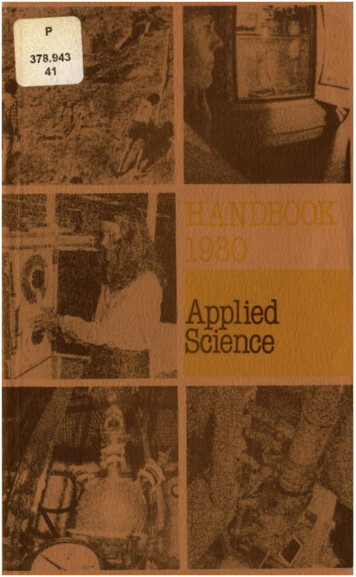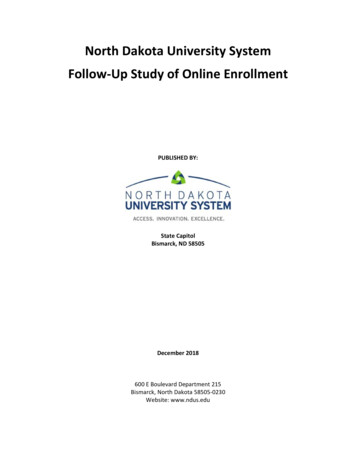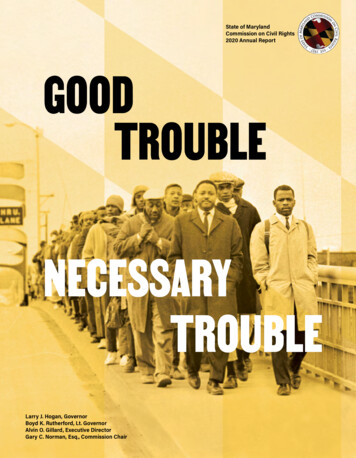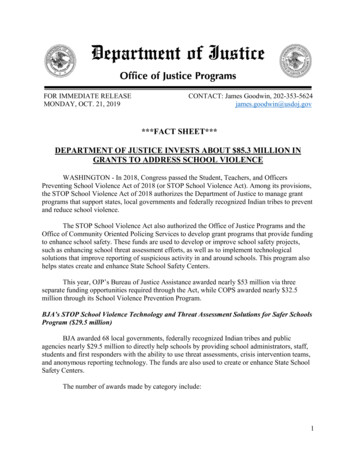
Transcription
Page 1 of 23U.S. Department of StateBureau of Population, Refugees, and Migration (PRM)FY 2023 Request for Concept Notes on Capacity Development andStrengthening of Domestic Refugee ResettlementTable of ContentsTable of Contents .1Project Description.3Summary .3Specific Guidance for Concept Notes . 5Federal Award Information .10Eligibility Information .11Application and Submission Instructions .12Application Review Information .20Federal Award Administration Information.21PRM Points of Contact .231
Page 2 of 23Request for Concept Notes Number: SFOP0009049Assistance Listing (CFDA) number: 19.510 - U.S. Refugee Admissions ProgramAnnouncement issuance date: Wednesday, June 8, 2022Proposal submission deadline: Monday, July 11, 2022, at 11:59:59 p.m. (23:59:59)EDT. Concept Notes submitted after this deadline will not be considered.Funding limits: Project proposals must not be less than the funding floor and not morethan the funding ceiling per activity area per year or they will be disqualified. (Note:See guidance below on the maximum allowed number of submitted concept notes.) Funding floor per year (lowest value): 50,000 Funding ceiling per year (highest value): 1,000,000Anticipated timeframe for notification of selection for full proposal development:PRM anticipates, but cannot guarantee, that within 60 days from the concept notesubmission deadline selected concept notes will be notified of selection for fullproposal development.Anticipated timeframe for award of selected full proposals: Pending the availability offunds, PRM anticipates, but cannot guarantee, that awards will be made less than four(4) months from the proposal submission deadline. Please note that awards for thedifferent capacity building areas may vary in their start dates.ADVISORY: All applicants must submit concept notes through the website Grants.gov.PRM strongly recommends submitting concept notes early to allow time to addressany technical difficulties that may arise on the Grants.gov website.2
Page 3 of 23If you are new to PRM funding, the Grants.gov website registration process can becomplicated. We urge you to refer to PRM’s General NGO Guidelines “ApplicationProcess” section for information and resources to help ensure that the applicationprocess runs smoothly. PRM also strongly encourages organizations that havereceived funding from PRM in the past to read this section as a refresher.PRM strongly recommends concept notes be submitted in Adobe PDF, as MicrosoftWord documents may sometimes produce different page lengths based on softwareversions and configurations when transmitted. Exceeding page length limits will resultin disqualification. All documents must be in English and should avoid the use ofjargon and spell out acronyms upon first use.Recommended templates for this notice of funding opportunity are included in thegrants.gov listing.Project DescriptionSummaryThe Bureau of Population, Refugees, and Migration (PRM) seeks concept notesproposing technical assistance or other types of specialized projects to develop andexpand the capacity and universe of partners participating in refugee resettlement inthe United States, particularly the Reception and Placement (R&P) Program and tostrengthen the outcomes of refugees resettled through the U.S. Refugee AdmissionsProgram. The R&P Program is funded by PRM to ensure optimal placement ofrefugees in local resettlement communities across the United States. After arrival inthese communities, local R&P agencies provide direct assistance to refugees duringtheir initial resettlement period of 30-90 days after arrival.To grow and strengthen the domestic capacity for placement of refugees incommunities across the United States and provide for effective initial resettlementservices, PRM intends to fund dedicated technical assistance and/or other types of3
Page 4 of 23specialized projects focused on addressing one or more of the following capacitybuilding areas:(1) generating strategies and solutions to identify and provide affordable,appropriate housing for newly arriving refugees;(2) deepening community engagement in refugee resettlement, including throughthe use of community sponsorship programs;(3) supporting and facilitating the entry of new partner organizations to participatein the R&P program; and(4) strengthening resettlement outcomes for refugees through innovations toexpand resettlement capacity and effectiveness to meet projected U.S. RefugeeAdmissions Program (USRAP) needs.Pending funding availability, PRM anticipates, but cannot guarantee, to fund one tofour awards through this funding opportunity. Each award will cover at least one ofthe capacity building areas discussed above, but an award may cover multiple or allareas. PRM anticipates, but cannot guarantee, funding between 50,000- 1,000,000per year for each capacity building area. If proposing activities covering multiplecapacity building areas, applicants must propose no more than 1,000,000 per areaper year and each concept note must address one capacity building area (see sectionbelow). PRM welcomes proposals from consortia and may also request that two ormore organizations combine concept notes into a partnership/consortium proposalduring the proposal development process. This solicitation is the first step in a twopart process.Number of Concept Note ApplicationsOrganizations may submit a maximum of one concept note per capacity building areafor a total of four concept notes. If an applicant chooses to submit more than oneconcept note, PRM expects to see cost savings, as applicable, among the multipleconcept notes (e.g., staffing costs may be partially charged to each concept note4
Page 5 of 23budget). Any subsequent submissions received beyond the allowable four, will bedisqualified.PRM is interested in multi-year programs for up to three years (36 months). Conceptnotes must not exceed a program period of three years.Specific Guidance for Concept NotesConcept notes should propose technical assistance or other specialized projects thatcan be made available as centralized resources to support organizations participatingin refugee resettlement in the United States. Proposed projects must address one ofthe four specified capacity building areas outlined below and must identify specificobjectives, strategies, and outcomes/results for the proposed project activities.Technical assistance and specialized support activities may include but are not limitedto: development of needs assessments/analysis; targeted initiatives; trainings/skill building opportunities; creation and dissemination of data/resources/materials; knowledge development/management; coordination platforms, and; innovative partnerships.To the extent possible, these types of activities should draw on research or evidencebased models and evidence-generating approaches. All proposed projects mustensure nonduplication of established activities at the local, state or federal level (e.g.,funding from the Office of Refugee Resettlement, Health and Human Services, CulturalOrientation Technical Assistance operated by the Cultural Orientation ResourceExchange). PRM is interested in projects that coordinate with, complement, andleverage existing relevant resources.5
Page 6 of 23Concept notes should describe plans for implementing technical assistance or othertypes of specialized projects, as described above, including an overview of theproposed staffing and funding that will be needed as well as a timeline forimplementation and expected outcomes. Suggested activities should incorporate, asrelevant, trauma-informed practices that create environments promoting a sense ofsafety, cultural sensitivity, and self-sufficiency. Further guidance for each topic is asfollows:Capacity Building Area 1: Strategies and Solutions on HousingThe ability of newly arrived refugees to move into safe, affordable long-term housingon arrival is a critical component of their successful initial resettlement. Given thechallenges that resettlement agencies (RAs) and other resettlement partners face insecuring such housing and the resulting impact on their ability to place refugees intocommunities, PRM intends to fund a technical assistance or specialized project withthe objective of helping RAs and other resettlement partners respond to the specificchallenges of identifying and sourcing affordable long-term housing options in localcommunities for newly arrived refugees during their initial resettlement period (30 to90 days after arrival). This technical assistance project may consider creatinginnovative housing opportunities that incorporate housing and life skills programmingand can draw on best practices more broadly around access to affordable housing forlow-income individuals or other similarly situated individuals (e.g., with minimal credithistory, etc.).Capacity Building Area 2: Deepening Community Engagement and SponsorshipRefugee resettlement in the United States has long benefited from, and indeed reliedupon, the successful engagement of local community actors, including through themobilization of volunteers and the development of resettlement agency cosponsorship programs. PRM supports the deepening of community engagement inresettlement as an avenue for further expanding the reception capacity of6
Page 7 of 23resettlement partners, particularly through co-sponsorship whereby local teams ofvolunteers or community-based organizations resettle refugees in coordination withlocal resettlement agencies. PRM intends to fund a technical assistance or specializedproject with the objective of supporting resettlement partners in mobilizing, recruiting,organizing, training, and overseeing community actors in resettlement, includingvolunteers, community partners, and co-sponsors, which work with local resettlementagencies to serve refugees. This project should have a strong focus on assistingresettlement agencies in establishing new or expanding existing co-sponsorshipprograms. The project should also consider the development of standardizedresources/tools which can be used internally by all R&P partners and public-facingresources/tools to help the general public navigate available volunteer and/or cosponsorship opportunities in their local communities. If proposing public-facingresources/tools, the project should address how it will coordinate with and/orcomplement the development of new resources that PRM will be separately funding tohelp the general public understand and engage with the pilot program for privatesponsorship of refugees, to be launched by PRM later in calendar year 2022.Capacity Building Area 3: Supporting Entry of New Participants in R&PPRM recognizes that organizations new to the R&P Program would benefit frommentorship and specific technical assistance from an established, experienced nationalresettlement agency to assist them in understanding how to effectively develop andmanage a national R&P Program implemented through a network of local offices andpartners. PRM intends to fund a technical assistance project with the objective ofleveraging existing R&P expertise to cultivate, guide, and support organizations whichare new to R&P. This technical assistance project should consider how to partner withand support approved new organization(s) to: Develop structures and systems for the national management of R&P; Support a network of new affiliates and community partners, includingdeveloping strategies for establishing, maintaining, and overseeing localresettlement operations;7
Page 8 of 23 Develop strategic placement plans on the basis of consultation withresettlement agencies operating in the same areas, state refugeecoordinators, state refugee health coordinators, and other critical localcommunity stakeholders; Develop co-sponsorship programs, recruit and manage volunteers, androbust community engagement activities. Develop organizational plans that can accommodate changes in refugeearrivals over time.Applicants should be aware that award of this specific capacity building area willbe dependent upon a new organization or organizations being approved forparticipation in the R&P Program at the national level for fiscal year (FY) 2023.Capacity Building Area 4: Strengthening Resettlement Outcomes through NewCapacity and Effectiveness InnovationsSuccessful initial resettlement outcomes for refugees and positioning them foreffective long-term integration, requires a number of elements, including localcommunity capacity consultation and stakeholder coordination, thoughtful placementstrategies, effective service delivery, sufficient capacity to meet basic needs in a timelymanner, and the use of targeted financial assistance. To further strengthen initialresettlement outcomes for refugees, PRM is interested in proposals for technicalassistance or other specialized projects that meet key refugee and partner capacityneeds through the development of innovative models that introduce and incorporatenew approaches and resources on resettlement. Proposals must demonstrate soundrationale or evidence for the effectiveness of these approaches. Proposed projectsmust not duplicate programming and funding available from other federal agencies.Examples of topics and activities that such projects could address may include but arenot limited to:8
Page 9 of 23 Implementing or researching evidence-based and/or evidence-generatingapproaches/solutions that optimize refugee outcomes and are informedby refugee experiences, such as data-driven placement strategies orassessment of the value of community sponsors/partners and otherresettlement pathways. Strengthening and maximizing effective stakeholder consultation/collaboration. Ensuring community connections to services that are critical to the holisticwell-being of refugees such as legal, mental health, and social supports. Developing, cultivating, harnessing, and/or directing private resources tostrategically meet demonstrated needs of resettled refugees and addressinitial resettlement challenges. Creating training opportunities that focus on engaging and preparingrefugees to transition into paid, stipend, or volunteer positions withresettlement agencies and other organizations that support refugeeresettlement and to participate in leadership opportunities that enablethem to draw on their perspectives and lived experiences (e.g., bydeveloping their capacity to serve as cultural or health care communitynavigators, cultural orientation facilitators, case managers, or otherpositions to support refugee resettlement). Developing specialized structures, initiatives, and/or tools to improve howparticularly vulnerable cases (e.g., individuals with significant physical andbehavioral health needs, youth aged 18-25 without familial support, caseswith specific protection concerns) are identified and matched withappropriate support (whether refugee-specific programs such as PreferredCommunities or mainstream supports), either before arrival or during thefirst 30 to 90 days after arrival.After reviewing concept notes, PRM anticipates but cannot guarantee, inviting no laterthan two months after submission, selected organizations to expand their submissions,9
Page 10 of 23as applicable, into multi-year (20-page) proposals with objectives, indicators, anddetailed budgets for each year of the project. Selected organizations will have 30calendar days after they are notified of their selection to complete their full proposals.Organizations may apply as consortia. For purposes of this notice, PRM considersconsortia to be a group of no fewer than three NGOs that comprise an agreement,combination, or group formed to undertake, or proposing to undertake, a capacitydevelopment project beyond the resources of any one member. To support anexpansion in the universe of resettlement organizations, PRM will prioritize conceptnotes from consortia that involve and/or propose to engage new organizations thathave not previously received direct PRM support. PRM will also prioritize proposalsfrom consortia that include, involve, or engage refugee-led organizations (establishedand led entirely by refugees or having them in over half of the decision-making roles).This announcement references PRM’s General NGO Guidelines, which containadditional information on PRM’s priorities and NGO funding strategy with whichselected organizations must comply. Please use both the General NGO Guidelines andthis announcement to ensure that your concept note submission is in full compliancewith PRM requirements and that the proposed activities are in line with PRM’spriorities. Concept note submissions that do not reflect the requirements outlined inthese guidelines will not be considered.Federal Award InformationA.Proposed project start dates: No earlier than October 1, 2022B.Duration of Activity: Applicants must submit multi-year concept notes withactivities and budgets that do not exceed three years from the proposed startdate. Budgets submitted in year one can be revised/updated each year.Continued funding after the initial 12-month period of performance requires the10
Page 11 of 23submission of a noncompeting single-year or multi-year proposal and will becontingent upon available funding, strong performance, and continuing need. Infunding a project one year, PRM makes no representations that it will continueto fund the project in successive years and encourages applicants to seek a widearray of donors to ensure long-term funding possibilities.Eligibility InformationEligible Applicants:a. Nonprofits having a 501(c)(3) status with IRS;b. Nonprofits without 501(c)(3) status with IRS;c. Private institutions of higher education; andd. Public and State-controlled institutions of higher education.Cost Sharing or Matching: Cost sharing, matching, or cost participation is not arequirement of an application in response to this funding announcement.Concept notes and later proposals for consideration should describe the sources andamounts of additional funding that may be utilized to complement PRM funding, andmeet the following criteria: Are not paid by the Federal Government under another Federal award; Are verifiable from the non-Federal entity's records; Are not included as contributions for any other Federal award; and Are necessary and reasonable for accomplishment of project objectives.Please include this information in the indicated column in the Budget Summary of theconcept note submission.Note: Though favorably looked upon, inclusion will not result in a competitive rankingincrease when evaluated.11
Page 12 of 23Application and Submission InstructionsA.Where to Request Application Package: Application packages may bedownloaded from full NOFO listing on www.Grants.gov.B.Content and Form of Application: Organizations may submit a maximum of oneconcept note per capacity building area only for maximum of four total conceptnotes per organization. Any subsequent submissions received will bedisqualified. (Note: Submissions by organizations as part of a consortium do notcount toward an individual organization’s submission limit.)Concept notes must not exceed 4 pages in length, including the table summary(or 5 pages if a consortia submission) submitted in Adobe PDF, using Times NewRoman, 12-point font, letter sized paper with one-inch margins on all sides.Concept notes that are longer than 4 pages (or 5 pages if a consortiasubmission) will be disqualified. PRM strongly recommends proposals be submitted in Adobe PDF, asMicrosoft Word documents may sometimes produce different pagelengths based on software versions and configurations. Exceeding page length limits will result in disqualification. (Do not includeadditional cover pages) All documents must be in English and should avoid the use of jargon andspell out acronyms upon first use.a. Concept note narratives must include the following categories, in anyarrangement. Brief problem statement (identification of need or gap to be addressed) Project description, rationale, and implementation plan12
Page 13 of 23 Proposed measurable outcomes (including refugee outcomes) Summary of the organization(s) and experience doing similar work Organizational structureb. A one-page Budget Summary in Excel format. (Note: Budget summaries shouldbe submitted as an attachment under the “budget narrative” section ingrants.gov.) Budget summaries do not count against the 4-page limit (or 5 pagesif a consortia submission). The budget summary is separate from SF-424, SFF24A, and SF-424B documents, which are also required and similarly do not fallwithin the page limit. The SF-424 family of forms may be downloaded throughgrants.gov. Budget summaries must include the following categories, anddisaggregated by year: Personnel allowances Benefits Travel Project equipment Supplies Contractual Construction Other direct costs Indirect costs Total amount requestedc. There should be no attachments, other than the budget summary (Excel) andSF-424 documents, to the concept note submission.d. To be considered for PRM funding, organizations must submit a completeapplication package including:13
Page 14 of 23 4-page concept note (or 5-page concept note for consortia); One-page budget summary (Excel) clearly indicating costs disaggregatedby year for the project period. The budget summary does not countagainst overall page limits. Signed completed SF-424, SF-424 A, and SF-424 B. These documents donot count against the page limit.o Note: Form SF-424B is required only for those applicants who havenot previously registered in SAM.gov or recertified their registrationin SAM.gov since February 2, 2019, and completed the onlinerepresentations and certifications. The SF-424 family forms areavailable for download on grants.gov.C. Consortia:Organizations may apply to this call as individual organizations or consortia; however,for consortia, one organization must be designated as the lead applicant at both theconcept note and full proposal stage.For purposes of consortia applying for PRM funding, PRM’s considers consortium tobe a group of no less than three NGOs that comprise an agreement, combination, orgroup formed to undertake, or proposing to undertake, a capacity developmentproject beyond the resources of any one member. PRM may request to review andapprove of substantive provisions of proposed sub-awards. Applicants may formconsortia in order to bring together organizations with varied expertise to propose acomprehensive project in one proposal. The consortium arrangement may allow forinclusion of technical strengths from multiple organizations, increased inclusion oflocal and national organizations, and/or the potential of much greater impactthrough collaboration.If the applicant is applying as a consortium, a description of how the consortia will beorganized and how lines of authority and decision-making will be managed across all14
Page 15 of 23team members and between the lead applicant and associate awardees should beincluded in the concept note. The prime applicant would be responsible for overallimplementation of the proposed project activities, preparation/presentation ofannual work plans, M&E planning, and required reporting to PRM. The primeapplicant should designate a single individual to be the liaison with PRM, althoughPRM would reserve the right to communicate with sub-grantees.D. Unique Entity Identifier (UEI) Number and System for Award Management(SAM).Note: On April 4, 2022, the DUNS Number was replaced by a “new, nonproprietary identifier” requested in, and assigned by, the System for AwardManagement (SAM.gov). This new identifier is being called the Unique EntityIdentifier (UEI). For more information on the process, visitGSA's website on the UEI transition.Each applicant is required to: be registered in SAM before submitting its application; provide a valid UEI number in its application; and continue to maintain an active SAM registration with current information at alltimes during which it has an active PRM award or an application or plan underconsideration by PRM.No federal award may be made to an applicant until the applicant has complied withall applicable UEI and SAM requirements and, if an applicant has not fully compliedwith the requirements by the time the PRM award is ready to be made, PRM maydetermine that the applicant is not qualified to receive a PRM award and use thatdetermination as a basis for making a PRM award to another applicant.E. Concept notes must be submitted via Grants.gov. Grants.gov registrationrequires a UEI number and active SAM.gov registration. If you are new to PRM15
Page 16 of 23funding, the Grants.gov registration process can be complicated. We urge you torefer to PRM’s General NGO Guidelines “Application Process” section forinformation and resources to help ensure that the application process runssmoothly. PRM also strongly encourages organizations that have received fundingfrom PRM in the past to read this section as a refresher. Applicants may also referto the “For Applicants” page on Grants.gov for complete details on requirements.Do not wait until the deadline to attempt to submit your application onGrants.gov. Organizations not registered with Grants.gov should register well inadvance of the deadline as it can take several weeks to finalize registration(sometimes longer for non-U.S.-based NGOs to receive required registrationnumbers). We also recommend that organizations, particularly first-timeapplicants, submit applications via Grants.gov no later than one week before thedeadline to avoid last-minute technical difficulties that could result in anapplication not being considered. PRM has extremely limited ability to correct orfacilitate rapid resolution of technical difficulties associated with grants.gov,SAM.gov or UEI number and registration issues. PRM partners must maintain anactive SAM registration with current and correct information at all times duringwhich they have an active federal award or an application under considerationby PRM or any federal agency.When registering with Grants.gov, organizations must designate points of contactand Authorized Organization Representatives (AORs). Organizations basedoutside the United States must also request and receive an NCAGE code prior toregistering with SAM.gov. Applicants experiencing technical difficulties with theSAM registration process should contact the Federal Service Desk (FSD) online orat 1-866-606-8220 (U.S.) and 1-334-206-7828 (International).16
Page 17 of 23Applications must be submitted under the authority of the AuthorizedOrganization Representative at the applicant organization. Having proposalssubmitted by agency headquarters helps to avoid possible technical problems.If you encounter technical difficulties with Grants.gov please contact theGrants.gov Help Desk at support@grants.gov or by calling 1-800-518-4726.Applicants who are unable to submit applications via Grants.gov due toGrants.gov technical difficulties and: who have reported the problem to the Grants.gov help desk; received a case number; have completed UEI and SAM.gov registrations and had a documented service request opened to research the problem;may contact the PRM NGO Coordinator before the submission deadline todetermine whether an alternative method of submission is appropriate. PRMmakes no guarantee to accept an application outside of the grants.gov system.It is the responsibility of each applicant to ensure the appropriate registrationsare in place and active. Failure to have the appropriate organizationalregistrations in place or experiencing issues resulting from discrepancies acrossregistration platforms is not considered a technical difficulty and is notjustification for an alternate means of submission.F. Submission Dates and Times. Announcement issuance date: Wednesday, June 8, 2022 Concept Note submission deadline: Monday, July 11, 2022, at 11:59:59 p.m.(23:59:59) EDT. Concept Notes submitted after this deadline will not beconsidered.17
Page 18 of 23 This solicitation is the first step in a two-part process. After reviewing conceptnotes, PRM will invite selected organizations to expand their submissions intofull-length proposals with detailed budgets. Selected organizations will have30 calendar days after they are notified of their selection to complete their fullproposals.G. Intergovernmental Review: Not ApplicableH. Funding Restrictions: Federal awards will not allow reimbursement of FederalAward costs without prior authorization by PRM.I. Other Submission Requirements. Branding and Marking StrategyThe following provisions will be included whenever assistance is awarded:The Recipient shall recognize the United States Government’s funding foractivities specified under this award at the project site with a graphic of the U.S.flag accompanied by one of the following two phrases based on the level offunding for the award:o Fully funded by the award: “Gift of the United States Government”o Partially funded by
(3) supporting and facilitating the entry of new partner organizations to participate in the R&P program; and (4) strengthening resettlement outcomes for refugees through innovations to expand resettlement capacity and effectiveness to meet projected U.S. Refugee Admissions Program (USRAP) needs.
